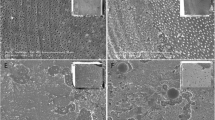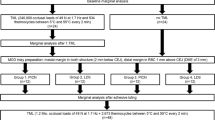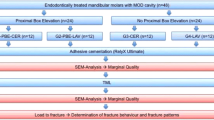Abstract
Objectives
This in vitro study evaluated the marginal quality of Lava Ultimate inlays in deep proximal cavities with and without proximal box elevation (PBE) before and after thermomechanical loading (TML).
Materials and methods
Mesio-occluso-distal cavities with proximal boxes beneath the cementoenamel junction (CEJ) were prepared in 24 human molars. Then, one of the proximal boxes was elevated with Filtek Supreme above the CEJ. The specimens were divided into three groups (n = 8). The inlays of group A were adhesively luted to the cavities with Scotchbond Universal and Rely X Ultimate, the inlays of group B with Monobond Plus, Syntac, and Variolink II, and the inlays of group C with Clearfil Ceramic Primer and Panavia SA Cement. Epoxy resin replicas were taken before and after thermomechanical loading (1,200,000 cycles, 55 °C/5 °C, max. load 50 N). Marginal integrity at the different interfaces tooth/PBE, tooth/dentine, inlay/PBE, inlay/dentine was evaluated with scanning electron microscopy (×200). The percentage of continuous margin (% of total proximal margin length) was compared between the groups before and after TML. Statistics: Mann-Whitney U test (p = 0.05).
Results
No significant differences (p > 0.05) before and after TML were found between the three groups for bonding the inlay to dentine or to PBE composite.
Conclusions
The marginal integrities of bonding inlays directly to dentine are not different from bonding inlays to a proximal box, which has been elevated by a composite filling material. For deep proximal cavities, the PBE technique could be an alternative technique to conventional methods. Clinical research is needed to confirm.



Similar content being viewed by others
References
Mehl A, Kunzelmann K, Folwaczny M, Hickel R (2004) Stabilization effects of CAD/CAM ceramic restorations in extended MOD cavities. J Adhes Dent 6:239–245
Attia A, Abdelaziz KM, Freitag S, Kern M (2006) Fracture load of composite resin and feldspathic all-ceramic CAD/CAM crowns. J Prosthet Dent 95:117–123
Harada A, Nakamura K, Kanno T, et al. (2015) Fracture resistance of computer-aided design/computer-aided manufacturing-generated composite resin-based molar crowns. Eur J Oral Sci 123:122–129
Giordano R (2006) Materials for chairside CAD/CAM–produced restorations. J Am Dent Assoc 137:14–21
Schmidt JC, Sahrmann P, Weiger R, Schmidlin PR, Walter C (2013) Biologic width dimensions--a systematic review. J Clin Periodontol 40:493–504
Dietschi D, Spreafico R (1998) Current clinical concepts for adhesive cementation of tooth-colored posterior restorations. Pract Periodontics Aesthet Dent 10:47–54
Frankenberger R, Hehn J, Hajtó J, et al. (2013) Effect of proximal box elevation with resin composite on marginal quality of ceramic inlays in vitro. Clin Oral Investig 17:177–183
Zaruba M, Göhring TN, Wegehaupt FJ, Attin T (2013) Influence of a proximal margin elevation technique on marginal adaptation of ceramic inlays. Acta Odontol Scand 71:317–324
Rosentritt M, Behr M, Gebhard R, Handel G (2006) Influence of stress simulation parameters on the fracture strength of all-ceramic fixed-partial dentures. Dent Mater 22:176–182
Brosius GBF (1995) SPSS base system and professional statistics, 1st edn. International Thomson Publishing, Bonn
Krejci I, Reich T, Lutz F, Albertoni M (1990) An in vitro test procedure for evaluating dental restoration systems. 1. A computer-controlled mastication simulator. Schweiz Monatsschr Zahnmed 100:953–960
Manhart J, Schmidt M, Chen HY, Kunzelmann KH, Hickel R (2001) Marginal quality of tooth-colored restorations in class II cavities after artificial aging. Oper Dent 26:357–366
Brosh T, Zary R, Pilo R, Gavish A (2012) Influence of periodontal ligament simulation and splints on strains developing at the cervical area of a tooth crown. Eur J Oral Sci 120:466–471
Brosh T, Porat N, Vardimon AD, Pilo R (2011) Appropriateness of viscoelastic soft materials as in vitro simulators of the periodontal ligament. J Oral Rehabil 38:929–939
Heintze SD (2006) How to qualify and validate wear simulation devices and methods. Dent Mater 22:712–734
Lambrechts P, Debels E, van Landuyt K, Peumans M, van Meerbeek B (2006) How to simulate wear? Overview of existing methods. Dent Mater 22:693–701
Manhart J, Chen H, Hamm G, Hickel R (2004) Buonocore memorial lecture. Review of the clinical survival of direct and indirect restorations in posterior teeth of the permanent dentition. Oper Dent 29:481–508
Roulet JF, Reich T, Blunck U, Noack M (1989) Quantitative margin analysis in the scanning electron microscope. Scanning Microsc 3:147–158
Dietschi D, Olsburgh S, Krejci I, Davidson C (2003) In vitro evaluation of marginal and internal adaptation after occlusal stressing of indirect class II composite restorations with different resinous bases. Eur J Oral Sci 111:73–80
Frankenberger R, Krämer N, Pelka M, Petschelt A (1999) Internal adaptation and overhang formation of direct class II resin composite restorations. Clin Oral Investig 3:208–215
Rocca GT, Gregor L, Sandoval MJ, Krejci I, Dietschi D (2012) In vitro evaluation of marginal and internal adaptation after occlusal stressing of indirect class II composite restorations with different resinous bases and interface treatments. "post-fatigue adaptation of indirect composite restorations". Clin Oral Investig 16:1385–1393
Soh MS, Yap AUJ, Siow KS (2003) The effectiveness of cure of LED and halogen curing lights at varying cavity depths. Oper Dent 28:707–715
El-Mowafy OM, Rubo MH (2000) Influence of composite inlay/onlay thickness on hardening of dual-cured resin cements. J Can Dental Assoc 66:147
Krämer N, Lohbauer U, Frankenberger R (2000) Adhesive luting of indirect restorations. Am J Dent 13:60D–76D
Frese C, Wolff D, Staehle HJ (2014) Proximal box elevation with resin composite and the dogma of biological width: clinical R2-technique and critical review. Oper Dent 39:22–31
Paolantonio M, D'ercole S, Perinetti G, et al. (2004) Clinical and microbiological effects of different restorative materials on the periodontal tissues adjacent to subgingival class V restorations. J Clin Periodontol 31:200–207
Flores-de-Jacoby L, Zafiropoulos GG, Ciancio S (1989) Effect of crown margin location on plaque and periodontal health. Int J Periodontics Restorative Dent 9:197–205
Dietschi DL (2003) Evaluation of marginal and internal adaptation of adhesive class II restorations. Dissertation, ACTA University of Amsterdam]
Author information
Authors and Affiliations
Corresponding author
Ethics declarations
Conflict of interest
The authors declare that they have no conflict of interests.
Funding
There was no external funding.
Ethical approval
This article does not contain any studies with human participants or animals performed by any of the authors.
Informed consent
It is not necessary, because no individual participants were included.
Rights and permissions
About this article
Cite this article
Müller, V., Friedl, KH., Friedl, K. et al. Influence of proximal box elevation technique on marginal integrity of adhesively luted Cerec inlays. Clin Oral Invest 21, 607–612 (2017). https://doi.org/10.1007/s00784-016-1927-8
Received:
Accepted:
Published:
Issue Date:
DOI: https://doi.org/10.1007/s00784-016-1927-8




